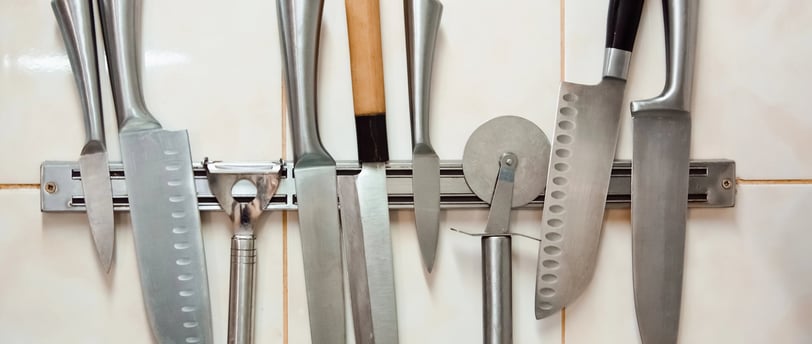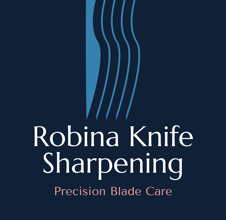Robina Knife Sharpening Book in for same-day service 0466 156 237 4 TIFFANY CLOSE. ROBINA
Ultimate Guide to Storing Knives for Blade Protection
Learn effective methods for storing knives to protect blades and prolong their lifespan, ensuring safety and optimal performance in your kitchen.
5/11/20255 min read


Ultimate Guide to Storing Knives for Blade Protection
Here’s how to store your knives effectively:
Countertop Knife Blocks: Convenient and organised for daily use.
Drawer Inserts: Space-saving with soft-lined slots for blade protection.
Magnetic Strips: Wall-mounted for easy access and ventilation.
Blade Guards: Ideal for individual knives, especially for travel or drawer storage.
Knife Bags: Perfect for transporting knives safely.
Key Tips:
Always clean and dry knives before storing.
Keep blades separated to prevent damage.
Use proper storage for different blade types (e.g., carbon steel, stainless steel, ceramic).
For long-term care, pair smart storage with regular maintenance like professional sharpening.
Common Knife Storage Methods
Storing your knives properly helps keep them sharp and extends their lifespan. Below, we explore popular storage options that protect your blades and suit various kitchen setups.
Countertop Knife Blocks
Wooden knife blocks are a classic choice for benchtop storage. To avoid damaging your knives, pick a block with slots that match your blade sizes. Universal blocks with adjustable inserts are also a great option if you have a mix of knife types.
Drawer Storage Systems
Drawer inserts provide a tidy, hidden storage solution. These systems often include soft-lined slots that keep blades secure and prevent them from bumping into each other.
Key features to look for:
Slots designed for different knife sizes
A non-slip base to keep the insert stable
Enough space between knives to avoid crowding
Protective linings to shield blades
Wall-Mounted Magnetic Strips
Magnetic strips are a space-saving option that also allows air to circulate around your knives. Install them about 30–40 cm above the benchtop for easy access.
When choosing a magnetic strip, ensure it has the right strength: weak magnets risk knives falling, while overly strong ones can damage the blades. Coated strips are ideal to prevent metal-on-metal contact.
Single Blade Protectors
Blade guards are ideal for individual knives, especially when travelling or storing them in a drawer. Make sure the guard fits snugly but doesn’t press against the cutting edge. Options include:
Hard plastic sheaths
Magnetic folding cases
Covers designed for specific blade shapes
Professional Knife Bags
Knife bags are perfect for chefs or anyone needing to transport knives safely. Look for bags with:
Padded compartments to protect blades
Secure closures to prevent accidents
Reinforced stitching for durability
Water-resistant materials for added protection
Choose a bag with enough compartments for your collection and extra pockets for tools or accessories.
No matter which method you choose, proper storage is key to keeping your knives in top condition.
Safe Storage Guidelines
Proper storage is key to keeping your knives sharp and lasting longer. Pairing smart storage with regular care ensures your blades stay in top shape.
Clean and Dry Storage
Wash knives right after use with warm water and a small amount of mild detergent. Dry them thoroughly with a clean tea towel, paying extra attention to the handle joint. Let them air dry briefly to remove any leftover moisture.
For carbon steel knives, apply a thin layer of food-grade mineral oil before storing. This helps prevent rust and keeps bacteria at bay.
Correct Storage Position
Follow these tips for proper knife storage:
Rest blades on their spine whenever possible.
Avoid letting blades touch each other.
Keep cutting edges free from any pressure.
Position handles for easy and safe access.
If using a magnetic strip, align knives with the spine against the strip. For knife blocks, insert them with the spine facing down.
Use either dedicated knife inserts or individual blade guards for drawer storage. Never leave unprotected knives loose in a drawer, as this can dull the blades and increase the risk of injury.
For high-end knives, consider regular maintenance by professionals, like the team at Robina Knife Sharpening, to ensure your storage methods are doing their job and protecting your investment.
Storage by Blade Type
Different blade materials need specific storage methods to keep them in good condition and ensure they last longer.
Carbon Steel Storage
Carbon steel knives require extra attention to avoid rust and oxidation. These blades perform well but need a dry environment and regular upkeep.
Store in a place with controlled humidity, ideally under 60%. Adding a silica gel packet nearby can help absorb moisture.
Before storing, apply a thin layer of food-grade mineral oil, wrap the blade in acid-free paper, and place it in a wooden block or leather roll.
Check weekly for signs of oxidation.
For long-term storage, use VCI paper to create a protective barrier.
Stainless Steel Care
Stainless steel knives are easier to maintain than carbon steel but still need proper storage to avoid micro-abrasions and keep the edge aligned.
Avoid storing stainless steel knives in environments with salt air or chemical cleaners, as these can cause damage over time.
Ceramic Knife Protection
Ceramic knives are sharp but fragile, making careful storage essential to avoid chips or cracks.
Use dedicated slots or original protective cases to store ceramic knives.
Keep them separate from metal utensils and avoid magnetic strips.
Ensure about 3 cm of space between blades to prevent contact.
For drawer storage, choose knife blocks with individual slots rather than blade guards, as the rigid support helps protect the ceramic material.
When transporting ceramic knives, use protective cases with foam inserts to cradle the blade and prevent pressure points that could cause tiny cracks.
For expert advice on knife care and storage, reach out to Robina Knife Sharpening (https://robinaknifesharpening.com) in Robina. They offer professional guidance and precision services.
Ongoing Knife Care
Taking care of your knives goes beyond just proper storage. Regular upkeep ensures they stay sharp, safe, and ready to use. It also helps catch small issues before they turn into bigger problems.
Regular Knife Checks
Inspecting your knives regularly is an easy way to maintain their condition. Here's what to look for:
Edge alignment: Gently run your finger along the spine to check for any warping.
Surface issues: Scan for discolouration or early signs of rust.
Handle integrity: Look for looseness or cracks where the blade connects to the handle.
Blade edge: Under good lighting, check for tiny chips or imperfections on the edge.
Keeping a simple maintenance log can be a big help. Record when each knife was last inspected or serviced – this can reveal patterns and let you know when professional care might be needed.
Professional Sharpening
Even with the best care, knives need professional sharpening from time to time to stay at their best. Robina Knife Sharpening offers expert wet stone sharpening to restore precision. Their same-day service includes:
Standard kitchen knives: $20 per blade
Specialty blades (serrated, cleavers, or Japanese steel): $25
Minor repairs and edge restoration
A thorough inspection and finishing
If you use certain knives heavily, consider more frequent sharpening to keep them in top condition. Regular professional care ensures your knives perform at their peak for longer.
Summary: Basic Storage Rules
Storing your knives correctly is key to keeping them sharp, safe, and long-lasting. Regular sharpening by a professional ensures your blades stay in top condition and last longer. Robina Knife Sharpening provides expert same-day sharpening services, with standard knives priced at $20 and specialty blades at $25.
Follow these simple storage tips to safeguard your knives and keep your kitchen running smoothly.
Contact
© 2025. All rights reserved.
4 Tiffany Close
Robina 4226

